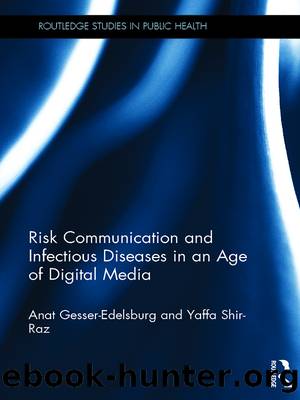Risk Communication and Infectious Diseases in an Age of Digital Media by Anat Gesser-Edelsburg Yaffa Shir-Raz

Author:Anat Gesser-Edelsburg, Yaffa Shir-Raz [Anat Gesser-Edelsburg, Yaffa Shir-Raz]
Language: eng
Format: epub
Tags: Social Science, Social Work
ISBN: 9781317287919
Google: XQh6DQAAQBAJ
Publisher: Routledge
Published: 2016-11-10T04:10:28+00:00
Pre-empting doubts about vaccine safety thus becomes a primary goal, and in order to achieve it, several of tactics are employed. A key tactic is aggregating all available data on the vaccineâs side effects in the publications and guides for the public, while leaving out any information that might spark doubts or reservations. For example, in December 2011, the Israeli Advisory Committee on Infectious Diseases and Immunization convened to discuss the following question: to what extent should parents be informed about possible side effects caused by vaccines their children receive? (Israeli Ministry of Health, 2011). Some of the committee members thought that the first draft of the manual published earlier that year was âtoo detailedâ and might therefore deter parents. They claimed the manual should only include common side effects, going as far as to dub severe but more rare side effects noted in the manufacturerâs leaflet âunnecessary and misleading informationâ: âIt is our duty to protect the vaccines from this unnecessary and misleading information,â determined one of the committee members. Moreover, it was further demanded that the side effects would be detailed âgenerically for every vaccine against a particular disease, rather than separately for each manufacturer,â although the vaccine formulas made by different manufacturers tend to differ, causing different potential side effects. Ultimately, the committee decided to correct the guide, reducing the list of side effects written in the manufacturerâs leaflet.
In the digital age, this aggregated information is presented on organization websites and social media feeds. The manner in which it is presented on those sites generates another tactic, which can be dubbed âredness in the injection site.â This tactic involves an opening statement arguing that the vaccine is âextremely safeâ (Collignon et al., 2010), followed by a list of minor side effects, such as redness, pain or swelling in the arm where the shot was given, while potential or even reported serious adverse events are omitted. The HPV vaccine is a striking example. Since it was first introduced, there have been persistent reports of post-HPV vaccine-linked autoimmunity, including Guillain-Barré Syndrome (Laino, 2009; Souayah et al., 2011) and autoimmune diseases, such as ovarian failure (Colafrancesco et al., 2013; Little and Ward, 2012, 2014), postural orthostatic tachycardia syndrome (POTS) with chronic fatigue (Tomljenovic et al., 2014), and other disabling syndromes of chronic neuropathic pain, fatigue, and autonomic dysfunction (MartÃnez-LavÃn et al., 2015). Following the increasing number of reports, experts throughout the world have been calling to conduct more studies and improve post-marketing surveillance (Colafrancesco et al., 2013; Little and Ward, 2014). In 2013, Japan withdrew its recommendation for HPV vaccine, due to concerns from the public about adverse events, and in 2015, guidelines for the evaluation and management of symptoms that begin after HPV vaccine injection were issued to healthcare professionals (Chustecka, 2015). In Canada, researchers demanded immediate suspension of the HPV vaccination program until its safety was established (Dyer, 2015), and in India, researchers, doctors, public health and women rights organizations submitted a memorandum to the government, urging it
Download
This site does not store any files on its server. We only index and link to content provided by other sites. Please contact the content providers to delete copyright contents if any and email us, we'll remove relevant links or contents immediately.
Introduction to Social Work Practice : A Practical Workbook by Herschel Knapp(285)
Selective Oxidation Catalysts Obtained by the Immobilization of Iron (III) Porphyrins on Layered Hydroxide Salts by Fernando Wypych Shirley Nakagaki & Guilherme Sippel Machado(276)
How Data Happened by Unknown(267)
Global Health Governance and Commercialisation of Public Health in India by Anuj Kapilashrami Rama V. Baru(221)
Unmasked by Emily Mendenhall(184)
Curing Cancerphobia by David Ropeik(175)
The Pandemic Divide by Gwendolyn L. Wright Lucas Hubbard and William A. Darity Jr(160)
Restoring Quality Health Care by Scott W. Atlas(150)
Feminist Global Health Security by Clare Wenham(150)
FALSE PANDEMICS: ARGUMENTS AGAINST THE RULE OF FEAR by Wolfgang Wodarg(147)
Transforming Health Care Scheduling and Access: Getting to Now by Gary Kaplan(145)
Oversight and Review of Clinical Gene Transfer Protocols: Assessing the Role of the Recombinant DNA Advisory Committee by Rebecca N. Koehler(144)
The Making of a Pandemic: Social, Political, and Psychological Perspectives on Covid-19 by John Ehrenreich(140)
Pandemic India by Arnold David;(139)
Into Africa, Out of Academia by Kwan Kew Lai(129)
Insane Society: A Sociology of Mental Health by Peter Morrall(129)
The Metropolitan Academic Medical Center by David E. Rogers Eli Ginzberg(128)
Psychosocial Interventions for Mental and Substance Use Disorders: A Framework for Establishing Evidence-Based Standards by Mary Jane England(128)
Risk Communication and Infectious Diseases in an Age of Digital Media by Anat Gesser-Edelsburg Yaffa Shir-Raz(127)
